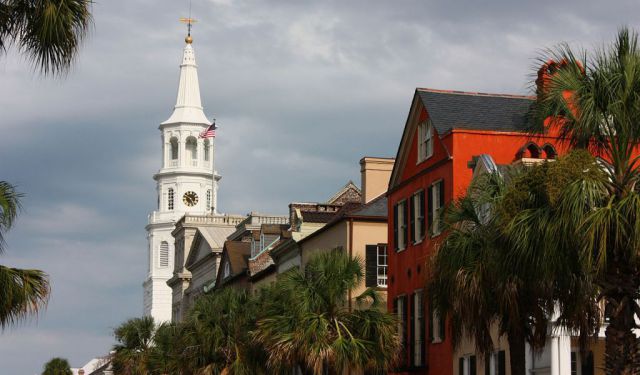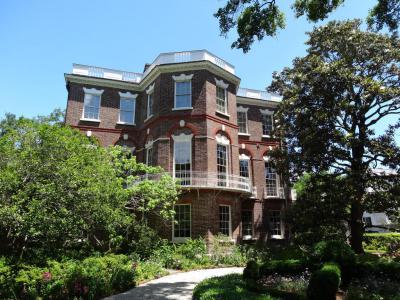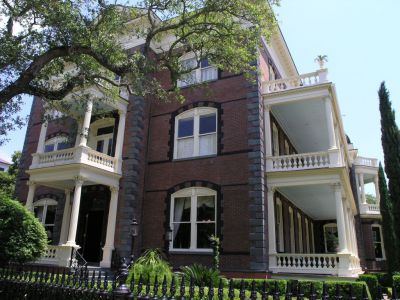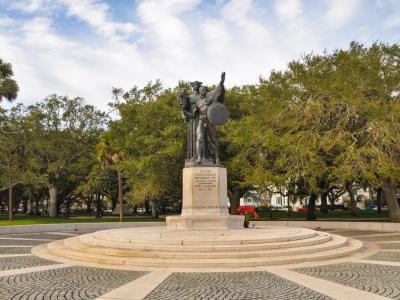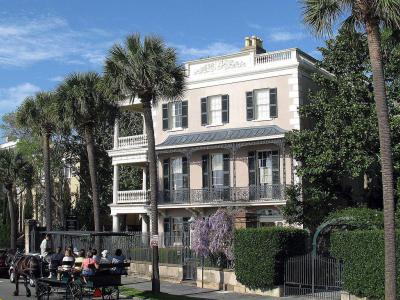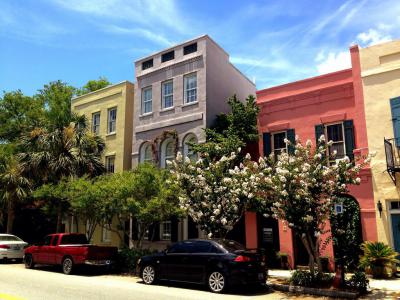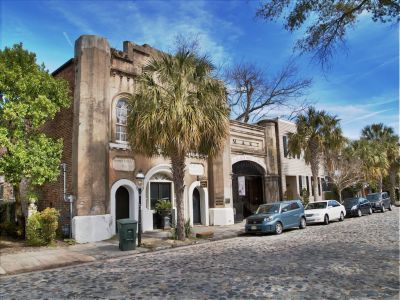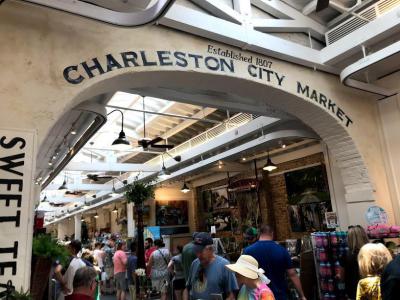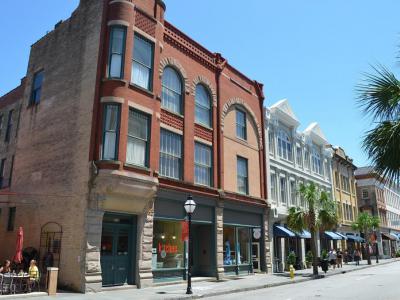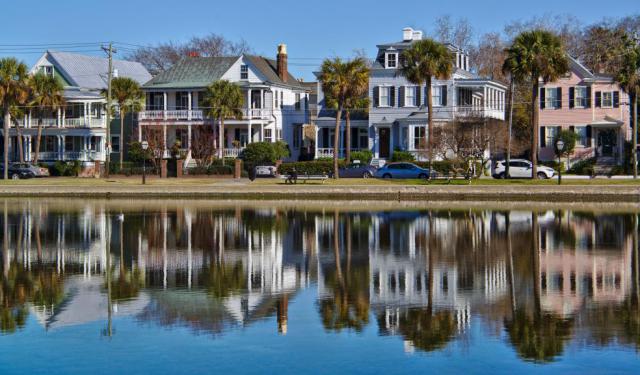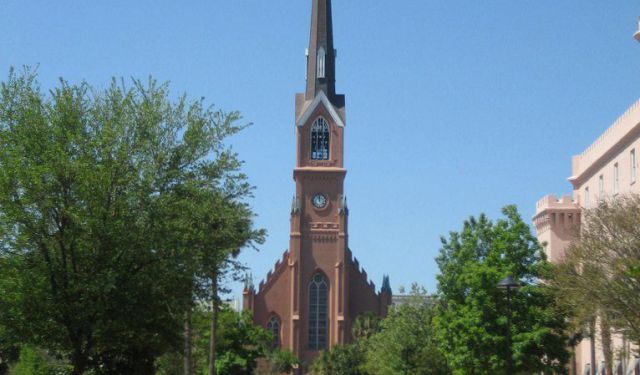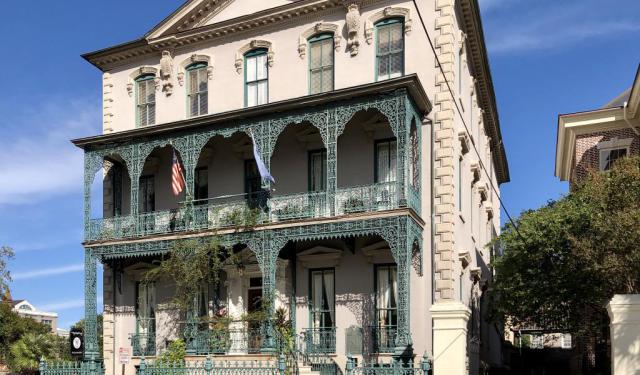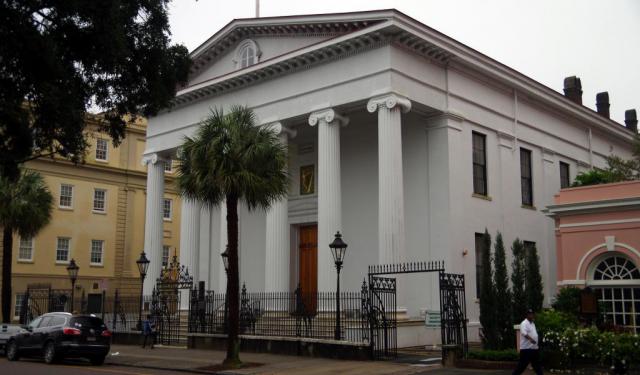Audio Guide: Charleston Introduction Walking Tour (Self Guided), Charleston
A popular tourist destination and a major port city in South Carolina, Charleston is fit to impress anyone with its Southern charm, friendliness, and rich history. Founded in 1670 as Charles Town, honoring King Charles II of England, this was the first comprehensively planned town in America.
The city's significance in American history is tied to its role as a key slave trading port. The locals pioneered large-scale slave trade of the 18th century, seeing almost half of all slaves imported to the United States arrive through Charleston. Slavery was again an important factor in the city's role during the Revolutionary War.
Charleston also played a major part in the Civil War, as a pivotal city where both the Union and Confederate Armies vied for power. The war had shattered the city's prosperity, but the freed African-American population had surged afterwards. In 2018, the city formally apologized for its role in the American Slave trade, condemning it as inhumane.
One of the places to learn about the city’s torrid past is the Old Slave Mart. Built in 1859, this was the last slave auction facility in South Carolina, which is now turned into a museum. Also, to learn about Charleston's Civil War history, you can visit the Confederate Museum at Market Hall.
Nowadays Charleston is known for its strong tourism industry; in 2016 Travel + Leisure Magazine ranked it as the best city in the world. Indeed, one of America's oldest cities is also exceptionally beautiful, defined by its cobblestone streets, horse-drawn carriages and pastel Antebellum houses, particularly in the elegant French Quarter and Battery districts.
Among other local attractions there are:
Rainbow Row – a colorful street filled with brightly painted 18th-century homes;
City Market – the beating heart of the Charleston Historic District, this 200-year-old market is a wonderful place to find handmade goods, including the famed sweetgrass baskets braided as you watch;
Old Exchange & Provost Dungeon – built in 1771, this building once housed a number of establishments, including the historic Provost Dungeon on its bottom floor, formerly used to accommodate British prisoners during the American Revolution.
Nicknamed "The Holy City", Charleston’s skyline is rich with steeples of numerous old churches. Among them is the French Huguenot Church in the French Quarter, the oldest Gothic Revival-style temple in South Carolina, built in 1844.
To explore these and other popular sights of Charleston, take this self-guided introductory walk!
The city's significance in American history is tied to its role as a key slave trading port. The locals pioneered large-scale slave trade of the 18th century, seeing almost half of all slaves imported to the United States arrive through Charleston. Slavery was again an important factor in the city's role during the Revolutionary War.
Charleston also played a major part in the Civil War, as a pivotal city where both the Union and Confederate Armies vied for power. The war had shattered the city's prosperity, but the freed African-American population had surged afterwards. In 2018, the city formally apologized for its role in the American Slave trade, condemning it as inhumane.
One of the places to learn about the city’s torrid past is the Old Slave Mart. Built in 1859, this was the last slave auction facility in South Carolina, which is now turned into a museum. Also, to learn about Charleston's Civil War history, you can visit the Confederate Museum at Market Hall.
Nowadays Charleston is known for its strong tourism industry; in 2016 Travel + Leisure Magazine ranked it as the best city in the world. Indeed, one of America's oldest cities is also exceptionally beautiful, defined by its cobblestone streets, horse-drawn carriages and pastel Antebellum houses, particularly in the elegant French Quarter and Battery districts.
Among other local attractions there are:
Rainbow Row – a colorful street filled with brightly painted 18th-century homes;
City Market – the beating heart of the Charleston Historic District, this 200-year-old market is a wonderful place to find handmade goods, including the famed sweetgrass baskets braided as you watch;
Old Exchange & Provost Dungeon – built in 1771, this building once housed a number of establishments, including the historic Provost Dungeon on its bottom floor, formerly used to accommodate British prisoners during the American Revolution.
Nicknamed "The Holy City", Charleston’s skyline is rich with steeples of numerous old churches. Among them is the French Huguenot Church in the French Quarter, the oldest Gothic Revival-style temple in South Carolina, built in 1844.
To explore these and other popular sights of Charleston, take this self-guided introductory walk!
How it works: Download the app "GPSmyCity: Walks in 1K+ Cities" from Apple App Store or Google Play Store to your mobile phone or tablet. The app turns your mobile device into a personal tour guide and its built-in GPS navigation functions guide you from one tour stop to next. The app works offline, so no data plan is needed when traveling abroad.
Charleston Introduction Walking Tour Map
Guide Name: Charleston Introduction Walking Tour
Guide Location: USA » Charleston (See other walking tours in Charleston)
Guide Type: Self-guided Walking Tour (Sightseeing)
# of Attractions: 14
Tour Duration: 2 Hour(s)
Travel Distance: 2.8 Km or 1.7 Miles
Author: DanaOffice
Sight(s) Featured in This Guide:
Guide Location: USA » Charleston (See other walking tours in Charleston)
Guide Type: Self-guided Walking Tour (Sightseeing)
# of Attractions: 14
Tour Duration: 2 Hour(s)
Travel Distance: 2.8 Km or 1.7 Miles
Author: DanaOffice
Sight(s) Featured in This Guide:
- Washington Square Park
- St. Michael's Church
- Nathaniel Russell House
- Williams Mansion (fka Calhoun Mansion)
- The Battery
- Edmondston-Alston House
- Rainbow Row
- Old Exchange and Provost Dungeon
- Old Slave Mart
- French Huguenot Church
- Circular Congregational Church
- Civil War Museum at Market Hall
- Historic City Market
- King Street
1) Washington Square Park
Located in the beautifully preserved historic district behind City Hall, Washington Square is Charleston's oldest public park, offering a tranquil escape in the heart of the city. Due to its proximity to some of the finest bars and restaurants, it's a popular stop on walking tours. There is plenty of shade and seating in the cozy fenced enclosure where you can relax, snap some photos, people-watch, or simply enjoy Charleston's charm.
Notably, the park features an obelisk-shaped memorial dedicated to the Washington Light Infantry – a miniature version of the obelisk in Washington D.C., made of Carolina gray granite. This memorial, unveiled in 1891, stands 42 feet tall and bears inscriptions of major military battles in U.S. history. Adjacent to it is a statue of George Washington, the "Father of the Nation", which was installed in 1999.
Tip:
The best time to visit the park is in the spring when trees are in bloom.
Notably, the park features an obelisk-shaped memorial dedicated to the Washington Light Infantry – a miniature version of the obelisk in Washington D.C., made of Carolina gray granite. This memorial, unveiled in 1891, stands 42 feet tall and bears inscriptions of major military battles in U.S. history. Adjacent to it is a statue of George Washington, the "Father of the Nation", which was installed in 1999.
Tip:
The best time to visit the park is in the spring when trees are in bloom.
2) St. Michael's Church (must see)
While Saint Philip's church can rightfully claim the title of Charleston's oldest congregation, Saint Michael's takes pride in being the city's oldest religious structure, completed in 1761. Its architect's identity remains a mystery, though there's no doubt that this exquisite building is one of Charleston's greatest architectural treasures, reflecting the influence of London's Saint Martin-in-the-Fields temple, designed in the 1720s.
Notably, Saint Michael's features a two-story portico with Tuscan columns, a pioneering architectural feature in colonial America. Adorning the north wall is a sizable stained glass window donated in 1898, showcasing a rendition of "Easter Morning". Composed of approximately 1,800 to 2,000 individual pieces, this masterpiece was crafted by artist and designer Louis Lederlie for Tiffany Studios. Additionally, the church tower houses a clock that chimes the hours and quarters, along with eight remarkable change-ringing bells, one of only four such sets in the Charleston area. These bells were initially cast in 1764 and later recast in 1866, both times in London.
The building has, for the most part, remained remarkably intact over the centuries, aside from the addition of a sacristy in 1883; nevertheless, it has endured significant repairs due to a series of natural and man-made disasters. In the earthquake of 1886, the steeple tower sank by 8 inches, resulting in several cracks throughout the church. Further damage was inflicted by a tornado in 1935 and Hurricane Hugo in 1989. During both the American Revolution and the Civil War, the spire was painted black to reduce its visibility as a target for enemy gunners.
A historical highlight includes President George Washington's visit to Charleston in 1791 when he attended a service at Saint Michael's, occupying the Governor's Pew, which is commemorated with a small plaque. The churchyard serves as the final resting place for several distinguished members of the congregation, including General Charles Cotesworth Pinckney, a Revolutionary War hero and signer of the Constitution, as well as John Rutledge, a signer of the Constitution and member of the U.S. Supreme Court.
Notably, Saint Michael's features a two-story portico with Tuscan columns, a pioneering architectural feature in colonial America. Adorning the north wall is a sizable stained glass window donated in 1898, showcasing a rendition of "Easter Morning". Composed of approximately 1,800 to 2,000 individual pieces, this masterpiece was crafted by artist and designer Louis Lederlie for Tiffany Studios. Additionally, the church tower houses a clock that chimes the hours and quarters, along with eight remarkable change-ringing bells, one of only four such sets in the Charleston area. These bells were initially cast in 1764 and later recast in 1866, both times in London.
The building has, for the most part, remained remarkably intact over the centuries, aside from the addition of a sacristy in 1883; nevertheless, it has endured significant repairs due to a series of natural and man-made disasters. In the earthquake of 1886, the steeple tower sank by 8 inches, resulting in several cracks throughout the church. Further damage was inflicted by a tornado in 1935 and Hurricane Hugo in 1989. During both the American Revolution and the Civil War, the spire was painted black to reduce its visibility as a target for enemy gunners.
A historical highlight includes President George Washington's visit to Charleston in 1791 when he attended a service at Saint Michael's, occupying the Governor's Pew, which is commemorated with a small plaque. The churchyard serves as the final resting place for several distinguished members of the congregation, including General Charles Cotesworth Pinckney, a Revolutionary War hero and signer of the Constitution, as well as John Rutledge, a signer of the Constitution and member of the U.S. Supreme Court.
3) Nathaniel Russell House (must see)
Nathaniel Russell, a prominent shipping merchant, chose to erect his grand "mansionhouse" on Meeting Street, strategically located within view of the busy wharves that fueled his prosperity. In 1808, at the age of 71, Russell's opulent residence was completed, at a reported cost of $80,000-an astronomical sum for its time. Inspired by the architectural style of English designer Robert Adam, who drew influence from the recently unearthed classical designs discovered in the Italian excavations of Pompeii and Herculaneum, Russell's new abode showcased a blend of elegance and classical influence.
Visitors today are immediately captivated by the breathtaking elliptical staircase, seemingly floating through three floors without any apparent support, set against a backdrop of golden walls in the stair hall. The Adamesque embellishments adorning the mantels and cornices of the fireplaces here also rank among the most intricate in the city.
Elegantly proportioned rooms exhibit a splendid array of Charleston, English, and French furnishings, including precious china, silver, and paintings. The oval drawing room on the second floor stands out as the most lavishly adorned space, and served as the retreat for women after dinner. Draped in an apricot palette, it features ornate plaster moldings coated with 24-karat gold leaf.
Unlike most other Charleston house museums, the Russell House has never been through a sad period of decline and disrepair. First as a fine town house, then as the home of a South Carolina governor, and later as a school for girls and even a convent, 51 Meeting Street has always been a respected and cared-for landmark. Today it is owned and operated by Historic Charleston Foundation, an organization that has done much to preserve and illuminate the city's architectural heritage.
To the south of the house lies a formal English garden with gravel paths, boxwood hedges, and 19th-century botanical favorites. At the rear, you'll find the two-story slave quarters that once accommodated the 18 enslaved individuals who lived and worked on the property.
Tip:
It's a good idea to arrive early, especially if you're planning a weekend tour. Online tickets don't come with specific time slots, and on-site tours are assigned on a first-come-first-served basis. While you're in the area, consider exploring the nearby old graveyard before or after your visit to the house. If you're interested, you can also opt for an additional fee to access the sister Aiken-Rhett House, farther uptown.
Visitors today are immediately captivated by the breathtaking elliptical staircase, seemingly floating through three floors without any apparent support, set against a backdrop of golden walls in the stair hall. The Adamesque embellishments adorning the mantels and cornices of the fireplaces here also rank among the most intricate in the city.
Elegantly proportioned rooms exhibit a splendid array of Charleston, English, and French furnishings, including precious china, silver, and paintings. The oval drawing room on the second floor stands out as the most lavishly adorned space, and served as the retreat for women after dinner. Draped in an apricot palette, it features ornate plaster moldings coated with 24-karat gold leaf.
Unlike most other Charleston house museums, the Russell House has never been through a sad period of decline and disrepair. First as a fine town house, then as the home of a South Carolina governor, and later as a school for girls and even a convent, 51 Meeting Street has always been a respected and cared-for landmark. Today it is owned and operated by Historic Charleston Foundation, an organization that has done much to preserve and illuminate the city's architectural heritage.
To the south of the house lies a formal English garden with gravel paths, boxwood hedges, and 19th-century botanical favorites. At the rear, you'll find the two-story slave quarters that once accommodated the 18 enslaved individuals who lived and worked on the property.
Tip:
It's a good idea to arrive early, especially if you're planning a weekend tour. Online tickets don't come with specific time slots, and on-site tours are assigned on a first-come-first-served basis. While you're in the area, consider exploring the nearby old graveyard before or after your visit to the house. If you're interested, you can also opt for an additional fee to access the sister Aiken-Rhett House, farther uptown.
4) Williams Mansion (fka Calhoun Mansion) (must see)
This house museum stands out as one of Charleston's few grand Victorian-era palaces; a remarkable example of the Italianate style that gained popularity in America during the latter half of the 19th century. In Charleston's diverse architectural landscape, this style is somewhat rare, possibly because it emerged at a time when the city was still grappling with the economic aftermath of the Civil War. During the postwar Reconstruction period, there was limited construction of grand mansions in Charleston; however, George Walton Williams, a wholesale grocer and banker, was undeterred by the city's economic challenges. Unlike many wealthy Southerners, he had made substantial investments in England and the North before the war.
Upon its completion in 1876, the grand Charleston residence garnered extravagant praise in newspapers from New York, Atlanta, and Charleston, which all touted it as "the handsomest and most-complete home in the South, if not the country." To this day, it remains Charleston's largest privately owned home, with its 35 rooms, 24,000 square feet of living space, 23 fireplaces, a three-tiered piazza, Italian water gardens adorned with fountains, and a towering cupola that rises 90 feet above Charleston Harbor.
The name "Calhoun" is associated with the house because Williams's son-in-law, Patrick Calhoun (grandson of John C. Calhoun, known as "The Great Nullifier"), resided here until 1929, when he lost the house and his fortune in the stock market crash. Subsequent owners struggled to find a suitable use for the historic mansion, leading to its gradual decline and eventual condemnation in the 1970s. However, a young local attorney acquired the property and spent a considerable fortune and 25 years restoring its structural and artistic grandeur.
Today, the mansion showcases the extensive personal collection of the new owner, featuring English and American furniture from the 18th and 19th centuries, with a focus on Southern decorative arts. There's also an impressive collection of impressionist art, Chinese ceramics, and various art objects that seamlessly blend with the Victorian-era ambiance originally designed to create an impressive display. The mansion has gained national recognition, appearing in numerous magazines and serving as a set for the notable television miniseries "North and South". While photography is not permitted inside, visitors can enjoy a 35-minute tour that provides informative insights into the mansion's history and significance. The grounds also offer charming garden spaces adorned with statues and fountains.
Upon its completion in 1876, the grand Charleston residence garnered extravagant praise in newspapers from New York, Atlanta, and Charleston, which all touted it as "the handsomest and most-complete home in the South, if not the country." To this day, it remains Charleston's largest privately owned home, with its 35 rooms, 24,000 square feet of living space, 23 fireplaces, a three-tiered piazza, Italian water gardens adorned with fountains, and a towering cupola that rises 90 feet above Charleston Harbor.
The name "Calhoun" is associated with the house because Williams's son-in-law, Patrick Calhoun (grandson of John C. Calhoun, known as "The Great Nullifier"), resided here until 1929, when he lost the house and his fortune in the stock market crash. Subsequent owners struggled to find a suitable use for the historic mansion, leading to its gradual decline and eventual condemnation in the 1970s. However, a young local attorney acquired the property and spent a considerable fortune and 25 years restoring its structural and artistic grandeur.
Today, the mansion showcases the extensive personal collection of the new owner, featuring English and American furniture from the 18th and 19th centuries, with a focus on Southern decorative arts. There's also an impressive collection of impressionist art, Chinese ceramics, and various art objects that seamlessly blend with the Victorian-era ambiance originally designed to create an impressive display. The mansion has gained national recognition, appearing in numerous magazines and serving as a set for the notable television miniseries "North and South". While photography is not permitted inside, visitors can enjoy a 35-minute tour that provides informative insights into the mansion's history and significance. The grounds also offer charming garden spaces adorned with statues and fountains.
5) The Battery (must see)
Charleston's White Point Garden, commonly known as the Battery, may not fit the traditional definition of an "attraction" like a museum or a fort, but it holds a unique place in the hearts of visitors and residents alike. While it's not an official attraction, it's almost a rite of passage for first-time visitors to stroll through this historic site. In a city where nearly every building and street holds historical significance, few places offer a more comprehensive glimpse into Charleston's 300-year history.
This picturesque spot at the eastern end of East Bay Street is now a serene park adorned with statues, monuments, ancient cannons, and majestic live oak trees-though the ambiance has not always been so tranquil. This site has been a prominent feature in Charleston since the early days of English settlement when it was known as Oyster Point due to its marshy beach covered in white oyster shells. Initially, it mainly served as a navigational aid for ships entering and leaving the harbor and only gained notoriety in the 1720s when infamous pirate Stede Bonnet and his crew were hanged here from makeshift gallows. These executions effectively put an end to pirate activities that had plagued the Carolina coast. Then, during the War of 1812, a fort was built in the area, giving rise to the popular name "the Battery".
The site was officially designated as a park in 1837 when the city reconfigured certain streets to create White Point Garden. It was from this vantage point that Charlestonians witnessed the opening shots of the Civil War on April 12, 1861, as Confederate fortifications across the river exchanged fire with Union troops stationed in Fort Sumter. Once the war started, this peaceful garden was dramatically transformed into two massive earthwork batteries as part of Charleston's inner defense line. While the end of the Civil War marked the conclusion of the Battery's military role, poignant reminders of subsequent wars remain in the form of cannons and monuments, each accompanied by informative plaques or markers.
As a tourist destination, the Battery is also famous for its collection of elegant, predominantly antebellum homes.
This picturesque spot at the eastern end of East Bay Street is now a serene park adorned with statues, monuments, ancient cannons, and majestic live oak trees-though the ambiance has not always been so tranquil. This site has been a prominent feature in Charleston since the early days of English settlement when it was known as Oyster Point due to its marshy beach covered in white oyster shells. Initially, it mainly served as a navigational aid for ships entering and leaving the harbor and only gained notoriety in the 1720s when infamous pirate Stede Bonnet and his crew were hanged here from makeshift gallows. These executions effectively put an end to pirate activities that had plagued the Carolina coast. Then, during the War of 1812, a fort was built in the area, giving rise to the popular name "the Battery".
The site was officially designated as a park in 1837 when the city reconfigured certain streets to create White Point Garden. It was from this vantage point that Charlestonians witnessed the opening shots of the Civil War on April 12, 1861, as Confederate fortifications across the river exchanged fire with Union troops stationed in Fort Sumter. Once the war started, this peaceful garden was dramatically transformed into two massive earthwork batteries as part of Charleston's inner defense line. While the end of the Civil War marked the conclusion of the Battery's military role, poignant reminders of subsequent wars remain in the form of cannons and monuments, each accompanied by informative plaques or markers.
As a tourist destination, the Battery is also famous for its collection of elegant, predominantly antebellum homes.
6) Edmondston-Alston House (must see)
In 1825, Charles Edmondston, a wealthy merchant and wharf owner, constructed this impressive three-story residence (originally of English Regency style) where he could enjoy unobstructed views of Charleston Harbor. The front staircase led to two drawing rooms on the second floor, with smaller rooms behind them serving as withdrawing spaces-one for ladies and one for gentlemen. The house featured 14-foot-high ceilings, large window and door openings for better airflow during the summer, and a library room. Additionally, the property featured a kitchen, servants' quarters, horse stables, and carriage facilities.
However, economic hardships stemming from the Panic of 1837 led Edmondston to sell the house to Charles Alston, a member of a prominent Low Country rice-planting family. Alston promptly renovated the architecture in the fashionable Greek Revival style. Additions included a third-story piazza with Corinthian columns, a cast-iron balcony across the front, and a rooftop railing displaying the Alston coat of arms. The Alstons received their visitors on the first floor, while social gatherings were held on the second floor.
Remarkably, many family documents, portraits, silver items, and fine furnishings from the 1830s, including Charles Alston's nearly intact library, can still be found today. Known for its unique Regency woodwork and uncompromising views of the harbor, the house's intimate atmosphere and authentic details may make visitors feel as though the Alstons only recently departed, perhaps for a countryside visit.
However, economic hardships stemming from the Panic of 1837 led Edmondston to sell the house to Charles Alston, a member of a prominent Low Country rice-planting family. Alston promptly renovated the architecture in the fashionable Greek Revival style. Additions included a third-story piazza with Corinthian columns, a cast-iron balcony across the front, and a rooftop railing displaying the Alston coat of arms. The Alstons received their visitors on the first floor, while social gatherings were held on the second floor.
Remarkably, many family documents, portraits, silver items, and fine furnishings from the 1830s, including Charles Alston's nearly intact library, can still be found today. Known for its unique Regency woodwork and uncompromising views of the harbor, the house's intimate atmosphere and authentic details may make visitors feel as though the Alstons only recently departed, perhaps for a countryside visit.
7) Rainbow Row (must see)
Rainbow Row, a series of thirteen pastel-colored mansions facing the Cooper River, is one of the most iconic and photographed sights in the United States. The vibrant, historically accurate colors are a testament to Charleston's Caribbean heritage, a legacy of the English settlers from Barbados who were among the city's earliest residents.
These homes are exceptionally old, considering Charleston's history of fires, hurricanes, and earthquakes. Most of them were built between 1730 and 1750 when they were located right along the Cooper River, serving as storefronts on the wharf. Later, the street was built on top of landfill, creating the current landscape.
Various myths surround the choice of colors. Some claim that intoxicated sailors returning from the port could remember their lodgings based on color, while others suggest that the colors were chosen to indicate the buildings' purpose as stores, making it easier for illiterate slaves to identify where they could shop.
One way or another, each of these houses has a fascinating story to tell about its origin and inhabitants. Despite facing natural calamities and the Civil War, they have remarkably remained intact and have weathered the test of time. If you examine them closely, you can see signs of renovations, including earthquake rods reinforcing the structures to ensure their stability.
Rainbow Row also holds significant importance in American historic preservation. These were the first Charleston homes to undergo restoration and recovery from early-20th-century deterioration. The restoration efforts on Rainbow Row directly inspired the creation of the Preservation Society of Charleston, the first organization of its kind in the United States.
These homes are exceptionally old, considering Charleston's history of fires, hurricanes, and earthquakes. Most of them were built between 1730 and 1750 when they were located right along the Cooper River, serving as storefronts on the wharf. Later, the street was built on top of landfill, creating the current landscape.
Various myths surround the choice of colors. Some claim that intoxicated sailors returning from the port could remember their lodgings based on color, while others suggest that the colors were chosen to indicate the buildings' purpose as stores, making it easier for illiterate slaves to identify where they could shop.
One way or another, each of these houses has a fascinating story to tell about its origin and inhabitants. Despite facing natural calamities and the Civil War, they have remarkably remained intact and have weathered the test of time. If you examine them closely, you can see signs of renovations, including earthquake rods reinforcing the structures to ensure their stability.
Rainbow Row also holds significant importance in American historic preservation. These were the first Charleston homes to undergo restoration and recovery from early-20th-century deterioration. The restoration efforts on Rainbow Row directly inspired the creation of the Preservation Society of Charleston, the first organization of its kind in the United States.
8) Old Exchange and Provost Dungeon (must see)
A public building has occupied the site at East Bay and Broad Streets since Charles Towne's relocation from its original settlement in 1680. The early settlers constructed a court of guard on this spot, using the lower level to imprison pirates and Native Americans, while holding town meetings in the upper hall. The British later erected the current building with striking Palladian architecture to make a grand statement in the bustling colonial port. Completed in 1771, the Exchange quickly became the social, political, and economic center of the growing city. From its steps, the independent colony of South Carolina was officially declared in March 1776.
During the Revolutionary War, the building was transformed into a British prison where signers of the Declaration of Independence were held. In 1788, the convention to ratify the U.S. Constitution convened at the Exchange, and President Washington was lavishly entertained here during his Southern tour. From 1815 to 1896, the Exchange served as both the Charleston post office for the Federal and Confederate governments. An excavation of the dungeon in 1965 revealed part of Charles Towne's original seawall, dating as early as 1698.
Now a National Historic Landmark, the building is open to the public as a museum and offers two halls available for private events. Guided tours, led by costumed guides on each floor, include a visit to the Provost Dungeon, where tales of pirates and colonial days come to life. The experience is both entertaining and educational, shedding light on the building's history and Charleston's unique past. If exploring a real dungeon is high on your bucket list, this place is a must-visit!
Tip:
Aside from delving into the property's rich history, there are engaging activities to enjoy, such as reenactments of the signing of the Declaration of Independence, allowing visitors to immerse themselves in the atmosphere of the 1700s.
During the Revolutionary War, the building was transformed into a British prison where signers of the Declaration of Independence were held. In 1788, the convention to ratify the U.S. Constitution convened at the Exchange, and President Washington was lavishly entertained here during his Southern tour. From 1815 to 1896, the Exchange served as both the Charleston post office for the Federal and Confederate governments. An excavation of the dungeon in 1965 revealed part of Charles Towne's original seawall, dating as early as 1698.
Now a National Historic Landmark, the building is open to the public as a museum and offers two halls available for private events. Guided tours, led by costumed guides on each floor, include a visit to the Provost Dungeon, where tales of pirates and colonial days come to life. The experience is both entertaining and educational, shedding light on the building's history and Charleston's unique past. If exploring a real dungeon is high on your bucket list, this place is a must-visit!
Tip:
Aside from delving into the property's rich history, there are engaging activities to enjoy, such as reenactments of the signing of the Declaration of Independence, allowing visitors to immerse themselves in the atmosphere of the 1700s.
9) Old Slave Mart (must see)
Constructed in 1859, this building, designed in the Gothic Revival and Romanesque styles with a stuccoed façade, originally formed part of the slave market known as Ryan's Mart. Named after city alderman and slave profiteer, Thomas Ryan, it occupied a large enclosed area between Chalmers and Queen Streets, consisting of a four-story slave jail, a kitchen, and a morgue referred to as the "dead house". With slave quarters having been demolished at most antebellum plantations, it is believed to be the last surviving site of a slave auction house.
Since 1938, it has been home to the Old Slave Mart Museum, a highly informative institution portraying the slave trading that occurred here between 1856 and 1863. The museum's knowledgeable staff is well-equipped to answer any questions that may arise while exploring the various exhibits. These delve into the transcontinental and domestic slave trade through large storyboards, personal narratives, and authentic artifacts, including shackles worn by slaves, the whips used to beat them, and even a deed of sale for auctioned slaves.
Among the self-guided educational materials is a firsthand audio account by former slave Elijah Green, born in 1843, who recounted his life's story in 1937. His account offers a sobering, realistic, and educational perspective on the nation's history, with a particular focus on Charleston's African-American heritage, spanning from slavery to emancipation.
Since 1938, it has been home to the Old Slave Mart Museum, a highly informative institution portraying the slave trading that occurred here between 1856 and 1863. The museum's knowledgeable staff is well-equipped to answer any questions that may arise while exploring the various exhibits. These delve into the transcontinental and domestic slave trade through large storyboards, personal narratives, and authentic artifacts, including shackles worn by slaves, the whips used to beat them, and even a deed of sale for auctioned slaves.
Among the self-guided educational materials is a firsthand audio account by former slave Elijah Green, born in 1843, who recounted his life's story in 1937. His account offers a sobering, realistic, and educational perspective on the nation's history, with a particular focus on Charleston's African-American heritage, spanning from slavery to emancipation.
10) French Huguenot Church
One of Charleston's oldest congregations, the French Huguenot Church, founded in the 1680s, also holds the distinction of being the only remaining independent Huguenot church in the United States. The original sanctuary, constructed in 1687, was intentionally destroyed as a firebreak during the major fire of 1796. Its successor, built in 1800, was also later demolished in favor of the current picturesque stucco-coated Gothic Revival temple, which was completed in the mid-1800s and was the first of its kind in the city.
Back in the 16th and 17th centuries, Huguenots in predominantly Catholic France faced persecution for their Protestant beliefs. After the Revocation of the Nantes Edict in 1685, many had fled France, with some finding refuge in North America. Charleston's early congregation included many of these refugees, and their descendants continued to play a significant role in the church's affairs for generations.
Originally affiliated with the Calvinist Reformed Church of France, the Huguenot Church still retains elements of Calvinist doctrine in its services, which are primarily conducted in English but follow the 18th-century French liturgy. Since 1950, an annual service conducted in French has been held to celebrate the arrival of spring.
Visitors to the church can request a brief tour from the on-duty docents, who provide insights into the Huguenot influence in early America and the church's history. The famous old Tracker organ, the Gothic ceiling, and external buttresses are all worthy of a look. While there is no admission fee or mandatory tour charge, donations are welcomed and used for the preservation of the historic building.
During the Spring and Fall, tours are available from 10 am to 4 pm on Mondays through Thursdays and from 10 am to 1 pm on Fridays.
Back in the 16th and 17th centuries, Huguenots in predominantly Catholic France faced persecution for their Protestant beliefs. After the Revocation of the Nantes Edict in 1685, many had fled France, with some finding refuge in North America. Charleston's early congregation included many of these refugees, and their descendants continued to play a significant role in the church's affairs for generations.
Originally affiliated with the Calvinist Reformed Church of France, the Huguenot Church still retains elements of Calvinist doctrine in its services, which are primarily conducted in English but follow the 18th-century French liturgy. Since 1950, an annual service conducted in French has been held to celebrate the arrival of spring.
Visitors to the church can request a brief tour from the on-duty docents, who provide insights into the Huguenot influence in early America and the church's history. The famous old Tracker organ, the Gothic ceiling, and external buttresses are all worthy of a look. While there is no admission fee or mandatory tour charge, donations are welcomed and used for the preservation of the historic building.
During the Spring and Fall, tours are available from 10 am to 4 pm on Mondays through Thursdays and from 10 am to 1 pm on Fridays.
11) Circular Congregational Church
Originally known as the Independent Church of Charles Towne, this church was founded in 1681 by some of the earliest settlers, including English Congregationalists, Scots Presbyterians, and French Huguenots. In fact, it was one of the first two congregations established in the settlement, the other being Saint Philip's Church.
The initial structure, made of white bricks, was known by locals as the "White Meeting House", which gave rise to the name of Meeting Street. In 1780, during the siege of Charleston, it was struck by a British cannonball, leading to its replacement in 1806 with the first "Circular Church", an impressive Pantheon-style structure designed by Charleston's esteemed architect, Robert Mills. Described at the time as "the most extraordinary building in the U.S.", it featured seven doors, 26 windows, and could accommodate 2,000 people, including both black and white congregants.
Unfortunately, the walls of the Circular Church did not survive for long, as the devastating fire of 1861 consumed the city. The third and current church, not precisely circular but designed with a modified cloverleaf pattern, was completed in 1892, using bricks salvaged from its predecessor. Alongside its unique architectural significance and rich history, the building also serves as a splendid venue for musical events held throughout the year.
Lying adjacent, the parish house is yet another remarkable Greek Revival creation by Robert Mills, featuring twin stairways and wrought iron railings. It has survived over the years and was designated a National Historic Landmark in 1973.
The city's oldest cemetery, located at the church, is also noteworthy as it contains numerous tombstones dating back to the 1690s.
The initial structure, made of white bricks, was known by locals as the "White Meeting House", which gave rise to the name of Meeting Street. In 1780, during the siege of Charleston, it was struck by a British cannonball, leading to its replacement in 1806 with the first "Circular Church", an impressive Pantheon-style structure designed by Charleston's esteemed architect, Robert Mills. Described at the time as "the most extraordinary building in the U.S.", it featured seven doors, 26 windows, and could accommodate 2,000 people, including both black and white congregants.
Unfortunately, the walls of the Circular Church did not survive for long, as the devastating fire of 1861 consumed the city. The third and current church, not precisely circular but designed with a modified cloverleaf pattern, was completed in 1892, using bricks salvaged from its predecessor. Alongside its unique architectural significance and rich history, the building also serves as a splendid venue for musical events held throughout the year.
Lying adjacent, the parish house is yet another remarkable Greek Revival creation by Robert Mills, featuring twin stairways and wrought iron railings. It has survived over the years and was designated a National Historic Landmark in 1973.
The city's oldest cemetery, located at the church, is also noteworthy as it contains numerous tombstones dating back to the 1690s.
12) Civil War Museum at Market Hall
Designed in the dignified Greek Revival style and currently restored to its original grandeur, the Market Hall building was renowned for its exceptional architectural quality when it was constructed in the 1840s. Modeled after the Temple of the Wingless Victory in Athens, Greece, this structure features a single elevated story resting upon a rusticated open ground-level arcade. Its portico contains four Roman-style Doric columns supporting the pediment and can be accessed via a double flight of stairs with intricate ironwork.
In a way, the building continues to fulfill its original purpose by serving as the front entrance to the adjoining six blocks of covered market space where a variety of fruits, meats, vegetables, and fish were historically sold. However, in 1899, the United Daughters of the Confederacy repurposed the Hall's second floor to establish a museum showcasing Confederate artifacts and other memorabilia from Charleston's Civil War era. While it may not rival the Museum of the Confederacy in Richmond, Virginia, this museum presents a remarkable collection of intriguing relics. Among the exhibits are cannons, uniforms, battle flags, swords, sabres, muskets, and even South Carolina's secession flag. Given the abundance of fascinating items on display, the nominal admission fee is well worth it.
Tip:
Don't forget to peruse the newspapers on display, as they provide a unique perspective on the Civil War.
In a way, the building continues to fulfill its original purpose by serving as the front entrance to the adjoining six blocks of covered market space where a variety of fruits, meats, vegetables, and fish were historically sold. However, in 1899, the United Daughters of the Confederacy repurposed the Hall's second floor to establish a museum showcasing Confederate artifacts and other memorabilia from Charleston's Civil War era. While it may not rival the Museum of the Confederacy in Richmond, Virginia, this museum presents a remarkable collection of intriguing relics. Among the exhibits are cannons, uniforms, battle flags, swords, sabres, muskets, and even South Carolina's secession flag. Given the abundance of fascinating items on display, the nominal admission fee is well worth it.
Tip:
Don't forget to peruse the newspapers on display, as they provide a unique perspective on the Civil War.
13) Historic City Market (must see)
A visit to Charleston would be incomplete without exploring the Historic City Market. Established in the 1790s, it spans four city blocks, covering a vast 33-acre area, starting from the temple-like Market Hall, which now houses the Confederate Museum.
Back in its prime during the early 20th century, the market provided a livelihood for thousands of African-American entrepreneurs and vendors. Today, it remains operational with dozens of vendors offering a wide range of souvenirs and goods, including clothing, jewelry, chocolates, artwork, Gullah sweetgrass baskets, and regional keepsakes.
Places of note include Callie's Hot Little Biscuit, Carolina Rice, Carolina Tea, and other eateries within the market. The surrounding area also has numerous shops, ice cream parlors, and restaurants, making it worthwhile to plan for several hours of exploration and enjoyment.
An excellent option for a rainy day visit (since it offers shelter), the market allows you to browse comfortably, stay dry, and hopefully discover some great deals. While credit cards are accepted, it's advisable to carry some cash as you might receive discounts for cash payments. Additionally, from April through December, the Night Market hosts local artists and food vendors on weekends.
The entire market complex was declared a National Historic Landmark and added to the National Register of Historic Places in 1973.
Back in its prime during the early 20th century, the market provided a livelihood for thousands of African-American entrepreneurs and vendors. Today, it remains operational with dozens of vendors offering a wide range of souvenirs and goods, including clothing, jewelry, chocolates, artwork, Gullah sweetgrass baskets, and regional keepsakes.
Places of note include Callie's Hot Little Biscuit, Carolina Rice, Carolina Tea, and other eateries within the market. The surrounding area also has numerous shops, ice cream parlors, and restaurants, making it worthwhile to plan for several hours of exploration and enjoyment.
An excellent option for a rainy day visit (since it offers shelter), the market allows you to browse comfortably, stay dry, and hopefully discover some great deals. While credit cards are accepted, it's advisable to carry some cash as you might receive discounts for cash payments. Additionally, from April through December, the Night Market hosts local artists and food vendors on weekends.
The entire market complex was declared a National Historic Landmark and added to the National Register of Historic Places in 1973.
14) King Street
King Street and its surroundings are, perhaps, the most happening areas in Charleston. It is also the second most historically and architecturally significant downtown lane, (after Meeting Street), where the city's past and present converge. With a history spanning more than three centuries, this thoroughfare was named for King Charles II of England and soon thrived as a retail corridor, commercial center, and a major shopping district, hosting a diverse array of high-end specialty shops.
Do you like it upscale? Even if not for shopping, a leisurely stroll down this street's pedestrian-friendly sidewalks impresses with stores offering unique and handmade jewelry, antiques, gifts, shoes, and fine clothing; as well as galleries showcasing the work of local artists and artisans. Peculiar enough, many local stores still "dress" their windows as they did back in the old days. There's also no shortage of trendy restaurants and cool little coffee and dessert shops here either, worth stopping by and taking a break.
With such an abundance of options, you may find yourself wondering where to begin your exploration. As you plan your visit, it's worth noting that King Street can be divided into three sections: the lower section, known for its top-notch antiques and jewelry boutiques; the middle section, home to upscale brand-name stores and some exceptional shoe shops; and the upper section, characterized by more cutting-edge boutiques and housewares stores (often locally owned and with a personal touch), along with a vibrant restaurant scene. Feel free to explore at your own pace and delight in the offerings of each section.
Tip:
Keep an eye out for "Second Sundays on King," an event where the street is closed to cars throughout the afternoon, spanning from Calhoun Street to Queen Street. Plus, don't miss the Saturday farmers' market in Marion Square during the spring and summer months.
Do you like it upscale? Even if not for shopping, a leisurely stroll down this street's pedestrian-friendly sidewalks impresses with stores offering unique and handmade jewelry, antiques, gifts, shoes, and fine clothing; as well as galleries showcasing the work of local artists and artisans. Peculiar enough, many local stores still "dress" their windows as they did back in the old days. There's also no shortage of trendy restaurants and cool little coffee and dessert shops here either, worth stopping by and taking a break.
With such an abundance of options, you may find yourself wondering where to begin your exploration. As you plan your visit, it's worth noting that King Street can be divided into three sections: the lower section, known for its top-notch antiques and jewelry boutiques; the middle section, home to upscale brand-name stores and some exceptional shoe shops; and the upper section, characterized by more cutting-edge boutiques and housewares stores (often locally owned and with a personal touch), along with a vibrant restaurant scene. Feel free to explore at your own pace and delight in the offerings of each section.
Tip:
Keep an eye out for "Second Sundays on King," an event where the street is closed to cars throughout the afternoon, spanning from Calhoun Street to Queen Street. Plus, don't miss the Saturday farmers' market in Marion Square during the spring and summer months.
Walking Tours in Charleston, South Carolina
Create Your Own Walk in Charleston
Creating your own self-guided walk in Charleston is easy and fun. Choose the city attractions that you want to see and a walk route map will be created just for you. You can even set your hotel as the start point of the walk.
Harleston Village Walking Tour
Founded in the 18th century, the historic Harleston Village is a charming neighborhood in Charleston, South Carolina. The rich past and vibrant present of this area make it a popular destination for tourists.
At the heart of Harleston Village lies the College of Charleston, an esteemed institution of higher learning, established in 1770, adding a great deal of academic flair to the... view more
Tour Duration: 2 Hour(s)
Travel Distance: 2.3 Km or 1.4 Miles
At the heart of Harleston Village lies the College of Charleston, an esteemed institution of higher learning, established in 1770, adding a great deal of academic flair to the... view more
Tour Duration: 2 Hour(s)
Travel Distance: 2.3 Km or 1.4 Miles
Downtown Historical Churches Tour
Charleston, South Carolina, is also sometimes called the “Holy City.” This is due to the large number of churches found here. Needless to say, the most fascinating of them are concentrated in the Downtown area, each with its unique charm and significance.
Among such temples of distinction is Saint Matthew's Church, an enduring symbol of Charleston's German Lutheran community. Its... view more
Tour Duration: 1 Hour(s)
Travel Distance: 1.3 Km or 0.8 Miles
Among such temples of distinction is Saint Matthew's Church, an enduring symbol of Charleston's German Lutheran community. Its... view more
Tour Duration: 1 Hour(s)
Travel Distance: 1.3 Km or 0.8 Miles
Historical Houses Tour
Charleston is steeped in history. Walking the colorful, narrow cobblestone streets of one of America's oldest towns, with its stunningly preserved colonial homes, you can see its story play out before your eyes practically everywhere you turn. Indeed, Charleston is among the most celebrated places in the U.S. to explore fine examples of American architecture and its progression through time.
... view more
Tour Duration: 2 Hour(s)
Travel Distance: 4.3 Km or 2.7 Miles
... view more
Tour Duration: 2 Hour(s)
Travel Distance: 4.3 Km or 2.7 Miles
French Quarter Walking Tour
A historic district in downtown Charleston, The French Quarter is named so for the high concentration of French merchants that once lived in the area and left their mark on it. The name was coined in 1973, when preservation efforts began for warehouse buildings on the Lodge Alley block. That same year the district was added to the National Register of Historic Places.
The busy neighbourhood... view more
Tour Duration: 1 Hour(s)
Travel Distance: 1.7 Km or 1.1 Miles
The busy neighbourhood... view more
Tour Duration: 1 Hour(s)
Travel Distance: 1.7 Km or 1.1 Miles
The Most Popular Cities
/ view all
